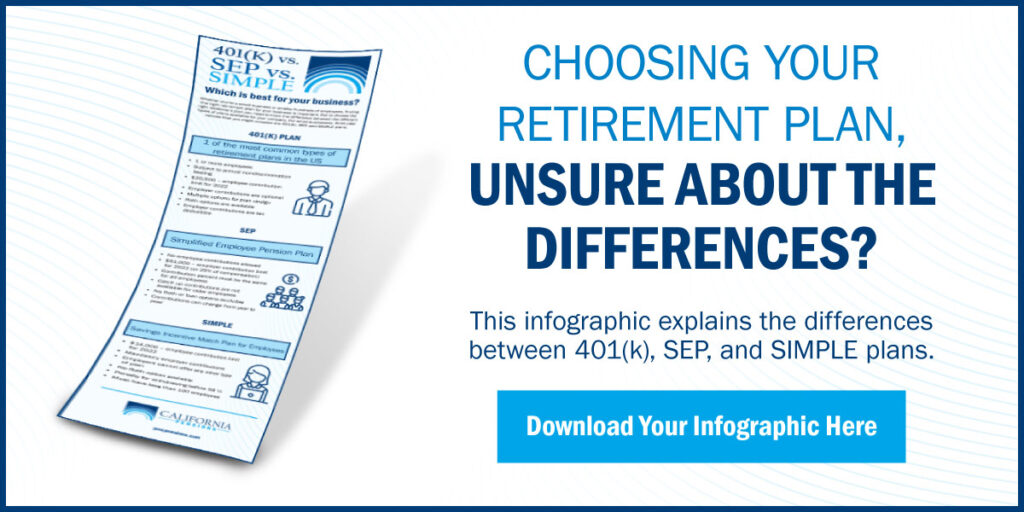A tax-deferred retirement plan is a retirement account that allows participants to postpone paying taxes on their invested money until it is withdrawn at retirement. The contributions into the account are made with pretax dollars which results in a lower income subject to taxes. There are multiple options for tax-deferred retirement plans, but what is the right plan for you? Let’s discuss.
Want to Learn About the Different Types of Retirement Plans? Download Our Guide!
401(k)
Among the most common types of tax-deferred retirement plans is a traditional 401(k). This plan is sponsored by your employer, or yourself if self-employed with contributions being deducted from your paycheck on a pretax basis. Please note that while your contributions are not subject to income tax, you still do pay Social Security, Medicare, and certain State and local taxes on them.
403(b)
For individuals who work in nonprofit sectors, you can take advantage of a 403(b) plan. If eligible, employers can establish accounts on behalf of their employees. With 403(b) plans there are three types of contributions that can be made into the tax-deferred retirement plan.
- Elective deferrals are approved contributions taken from your paycheck by your employer.
- Non-elective contributions are contributions made by your employers separate from your paycheck.
- After-tax contributions are made after income taxes are subtracted from your paycheck.
IRC 457(b)
Similar to 403(b), 457(b) retirement plans are for individuals who work in state or local government. To qualify for this plan, entities must be defined in the IRC 457 or IRC 501. This retirement plan is considered a non-qualified, tax-deferred plan which means it does not fall under the Employee Retirement Income Security Act.
Traditional IRA
An individual retirement account (IRA) does not require the sponsorship of an employer. Unlike the tax-deferred retirement plans, an IRA typically has more rules from the IRS including maximum contributions, when you have to start taken distributions and penalties associated with taking withdraws before that age. The contributions made to the traditional IRA are tax-deductible and will grow until withdrawn tax-free.

Simplified Employee Pension (SEP)
SEPs are individual tax-deferred retirement plans that are designed to allow employers a more straightforward method to contribute to their employee’s accounts. A SEP differs from a traditional IRA in that it allows for employer contributions. SEPs are a good choice for employers because they do not require the hefty start-up and operating costs of most employer-sponsored plans. Employers who make contributions to the SEP can deduct 100% of all contributions each year.
SIMPLE IRAs
A SIMPLE IRA is specifically for small businesses with 100 or fewer employees. Many small businesses use SIMPLE IRAs because they are easy to manage and involve little costs. A SIMPLE IRA is a tax-deferred plan that allows employees to put a percentage of their pay aside for retirement. Since it is tax-deferred the money will grow until it is withdrawn at retirement. Employers are required to match a small percentage of their employees’ contributions. SIMPLE IRA plans are an excellent choice if you are looking for an easy to set up retirement account that allows for employees to save for retirement with little effort.
Benefits of Tax-Deferred Retirement Plans
As with many retirement plans, the overarching goal is to encourage Americans to begin saving and planning for retirement. Tax-deferred retirement plans provide several benefits including:
- Reducing the amount of federal taxes owed annually. By contributing to a tax-deferred retirement plan, the taxable earned income will be reduced by the contributions which in turn will reduce your federal taxes.
- Since contributions are taken pre-tax, the money will grow steadily until retirement depending on the type of investment account you choose.
- By investing in a retirement account, you will be able to draw from the fund after you retire as a source of income.
When it comes to your retirement, the bottom line is being prepared. When it comes to a tax-deferred retirement plan you will be putting off taxes until you need the invested money in retirement. There are many plans to choose from, but investing in your future is the most important part. If you have questions about what plan is best for you – contact us today. The team at California Pensions is prepared to assist you in making the right investment decisions and preparations for retirement.





